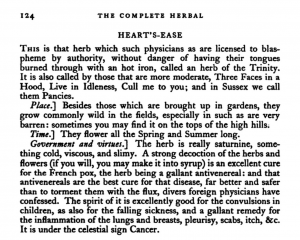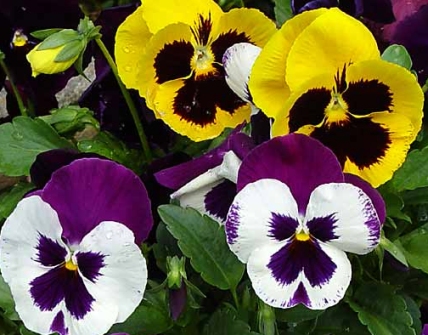Love-in-idleness, a flower commonly known as the pansy, botanically known as viola tricolor, German-ly known as the Stiefmuetterchenkraut, amusingly known as the kiss-her-in-the-buttery, and traditionally known as heartsease, is one of the many plants that William Shakespeare referenced in his plays. As one of the most common and popular field flowers across Europe, the pansy has inspired a variety of legends. As Shakespeare recounts in A Midsummer Night’s Dream, one popular tale states that the flower was originally pure white until it was struck by Cupid’s arrow. The wound from the arrow formed the dark purple center of the petals. This tale of Cupid, coupled with the flower’s name, from the French “pensée,” meaning thought, and its heart-shaped petals, has linked the pansy with ideas of love, lovers, and dreaming.
In addition to its mythological and symbolic significance, the pansy has a long scientific history. in Shakespeare’s time, botany, or the study of plants, was a popular science that much of the population incorporated into their every day lives through gardening and home remedies. Shakespeare clearly had some basic understanding of botany; he discusses flowers and plants several times throughout his works, both in the mythological senses, as in A Midsummer Night’s Dream, and in their medical senses. For example, the apothecary in Romeo and Juliet uses plants and botanical science to concoct Juliet’s sleeping tincture.
Shakespeare likely got most of his botanical knowledge from John Gerard’s Herball or Historie of Plantes. The Herball, published in 1597, was one of the first comprehensive botany books in the English language. It has an extensive entry about pansies, spelled by Gerard as “Paunsies,” and also referred to by another popular name, “Heartsease.”
John Gerard’s entry on pansies in his Herball.
After the detailed illustration and physical description of the plant, Gerard describes the practical medicinal uses of the plant, as accepted at the time:
“It is commended againft inflammations of the lungs and cheft, and againft fcabs and itchings of the whole body, and healeth ulcers.”
He also describes the process by which one could use the plant to make a tincture which would help to cure the “French disease,” better-known today as syphilis. Although Gerard’s accounts of many plants in the Herball were quite flawed, especially as compared to even earlier works in Old Flemish and Latin by botanist Rembert Dodoens, they were widely consulted by the literate populace and cited by botanists for centuries to come.
 Gerard’s influence is apparent in the Herbal of another well-known botanist from the 17th century, Nicholas Culpeper. In his Complete Herbal: A Book of Natural Remedies for Ancient Ills, Culpeper restates Gerard’s claims that a pansy tincture can be used to treat the French pox and other forms of venereal disease. He also praises it for its uses as an anti-inflammatory and for its abilities to treat itches and scabs–all properties first mentioned by Gerard.
Gerard’s influence is apparent in the Herbal of another well-known botanist from the 17th century, Nicholas Culpeper. In his Complete Herbal: A Book of Natural Remedies for Ancient Ills, Culpeper restates Gerard’s claims that a pansy tincture can be used to treat the French pox and other forms of venereal disease. He also praises it for its uses as an anti-inflammatory and for its abilities to treat itches and scabs–all properties first mentioned by Gerard.
Today, pansies are better-known for their aesthetic qualities than folksy tinctures and are more likely to be found in a garden or field of wildflowers than in a medicine cabinet. However, there are still some herbal remedies companies like this one that recommend pansies for many of the same traditional purposes, specifically to consume to treat coughs and other respiratory problems, or for anti-inflammation purposes. Although the sites always include disclosure information that the science behind these treatments is scant, the traditional remedies are still somewhat relevant.
They may even be more relevant than we realize. Though herbal supplement companies always include health disclaimers about scant evidence, the science behind the use of pansies in medicine may be becoming less scant. In 2008, several papers were published analyzing flavonoids in heartsease. Flavonoids are antioxidant-containing compounds that are thought to have health effects. In one of the 2008 studies, by authors Vukics, Kery, and Guttman, their results “suggest that garden pansy, especially its flower, is a promising source of natural antioxidants.” Perhaps John Gerard didn’t miss the mark 400 years ago, and we ought to include Johnny Jump-ups in our daily diets.


